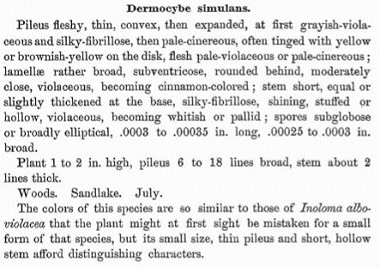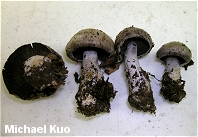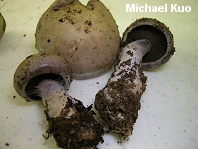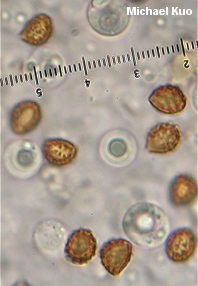| Major Groups > Gilled Mushrooms > Dark-Spored > Cortinarius > Cortinarius anomalus |

|
Cortinarius anomalus [Basidiomycetes > Agaricales > Cortinariaceae > Cortinarius ... ] by Michael Kuo "Cortinarius anomalus" is a name applied to members of what is probably a large group of species world-wide. Key physical features for the group include a medium-sized cap that features grayish silkiness and lilac shades when young, but becomes more brownish and develops a sheen with age; gills that are lilac gray when young; a slender stem that has a lilac apex and a base covered with whitish to yellowish material; and widely ellipsoid to nearly round, warty spores. The species is reported under a wide variety of hardwoods and conifers in a variety of ecosystems--further reason to suspect that several species must be involved. Cortinarius azureus is a similar but more uniformly lilac species associated with beech. Description: Ecology: Mycorrhizal with hardwoods or conifers; growing alone or gregariously; fall; apparently widely distributed in North America. Cap: 2-6 cm; convex, becoming broadly convex, flat, or slightly bell-shaped; dry; silky when young, developing a sheen with age; color variable, but generally grayish lilac to lilac brown when young, becoming more brown from the center outward. Gills: Attached to the stem; close; lilac gray at first, becoming rusty brown; covered by a whitish cortina when young. Stem: 3-8 cm long; up to 2 cm thick; equal or slightly swollen at the base; dry; lilac near the apex, at least when young; when young covered with whitish to yellowish veil material that breaks up into bands or sometimes disappears with maturity; solid, becoming hollow. Flesh: Whitish to lilac (especially in the stem). Odor: Sweet and slightly unpleasant, or not distinctive. Spore Print: Rusty brown. Microscopic Features: Spores 7-9 x 6-7 µ; subglobose to very broadly ellipsoid; moderately verrucose. Cheilo- and pleurocystidia absent. Pileipellis a cutis. REFERENCES: (Persoon, 1796) Fries, 1838. (Fries, 1821; Saccardo, 1887; Kauffman, 1918; Kauffman, 1932; Moser, 1983; Phillips, 1991/2005; Hansen & Knudsen, 1992; Evenson, 1997; Breitenbach & Kränzlin, 2000.) Herb. Kuo 09260901. Kauffman (1918) suggests the possibility that Dermocybe simulans Peck (1887; description below) may represent Cortinarius anomalus. If it is the case that one or more North American members of the anomalus group are eventually found to be phylogenetically distinct from the European species, Peck's name might find its way back into circulation. Peck, C. H. (1887), Bulletin of the New York State Museum 2: 8.
This site contains no information about the edibility or toxicity of mushrooms. |
© MushroomExpert.Com |
|
Cite this page as: Kuo, M. (2011, December). Cortinarius anomalus. Retrieved from the MushroomExpert.Com Web site: http://www.mushroomexpert.com/cortinarius_anomalus.html |



